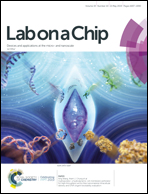High-throughput acoustofluidic fabrication of tumor spheroids†
Abstract
Three-dimensional (3D) culture of multicellular spheroids, offering a desirable biomimetic microenvironment, is appropriate for recapitulating tissue cellular adhesive complexity and revealing a more realistic drug response. However, current 3D culture methods are suffering from low-throughput, poor controllability, intensive-labor, and variation in spheroid size, thus not ready for many high-throughput screening applications including drug discovery and toxicity testing. Herein, we developed a high-throughput multicellular spheroid fabrication method using acoustofluidics. By acoustically-assembling cancer cells with low-cost and disposable devices, our method can produce more than 12 000 multicellular aggregates within several minutes and allow us to transfer these aggregates into ultra-low attachment dishes for long-term culture. This method can generate more than 6000 tumor spheroids per operation, and reduce tumor spheroid formation time to one day. Our platform has advantages in forming spheroids with high throughput, short time, and long-term effectiveness, and is easy-to-operation. This acoustofluidic spheroid assembly method provides a simple and efficient way to produce large numbers of uniform-sized spheroids for biomedical applications in translational medicine, pharmaceutical industry and basic life science research.



 Please wait while we load your content...
Please wait while we load your content...